The following speech was delivered for the Sunrise Foundation Lecture at Yale’s Jackson School of Global Affairs on April 19, 2023. It has been lightly edited.
In July 1963, when four countries had nuclear weapons, President John F. Kennedy warned of the dangers of nuclear proliferation. He urged his audience “to stop and think for a moment what it would mean to have nuclear weapons in so many hands, in the hands of countries large and small, stable and unstable, responsible and irresponsible, scattered throughout the world. There would be no rest for anyone then, no stability, no real security, and no chance of effective disarmament.”
Since then, U.S. administrations of both political parties have shared Kennedy’s concern about the spread of nuclear weapons. They feared:
- that proliferation would increase the probability that nuclear weapons would be used, whether intentionally or as the result of accident or misperception;
- that hostile nuclear-armed states would be more inclined to act aggressively in their regions against U.S. allies and U.S. interests; and
- that the worldwide dispersion of nuclear weapons and materials would magnify the risks of “loose nukes” and nuclear terrorism.
Not least — although not advertised by U.S. officials — they recognized that additional centers of nuclear decisionmaking could make it more difficult for Washington to shape and control events in a less predictable and more multipolar world.
And so, preventing nuclear proliferation has been a major goal of U.S. national security policy for over half a century. And the record shows that efforts to block the spread of nuclear weapons have been enormously successful.
191 countries have joined the 1968 Nuclear Non-Proliferation Treaty, the NPT. 30 years ago, nine countries had nuclear weapons — the five permanent members of the U.N. Security Council, India, Israel, Pakistan, and North Korea. Today, 30 years later, there are still nine nuclear-armed states, the same ones.
During that period, South Africa joined the NPT after voluntarily dismantling its small nuclear arsenal. Iraq, Libya, and Syria were coerced, militarily or diplomatically, to halt their nuclear weapons programs. Iran put its nuclear ambitions on hold in an agreement with six major powers. Ukraine, Kazakhstan, and Belarus agreed to remove Soviet-era nuclear weapons from their territories and joined the NPT as non-nuclear weapon states. Argentina and Brazil both joined the NPT after ending their nuclear weapons programs in their transitions from military to civilian rule.
It’s a remarkable record. But can it be sustained? A number of developments in recent years may have increased the likelihood that additional countries will decide to go nuclear.
One such development is Russia’s invasion of Ukraine. Russian President Vladimir Putin’s attack on non-nuclear Ukraine could persuade other non-nuclear states that they need nuclear weapons to guarantee their security. The perception that Putin’s nuclear saber-rattling has succeeded in deterring NATO’s direct intervention in the conflict — and in limiting the kinds of military assistance the West is willing to provide Ukraine — could encourage countries like North Korea and China to brandish nuclear weapons in a crisis in order to deter the United States from coming to the aid of its allies. And this perception of the success of nuclear saber-rattling could heighten fears by non-nuclear states that they might be abandoned by a nuclear-armed protector and left to fend for themselves.
A second worrisome development is the rapid expansion of North Korea’s nuclear and missile capabilities, which threaten both South Korea and Japan. Following the failed 2019 summit meeting in Hanoi between President Donald Trump and North Korean leader Kim Jong Un, there have been no negotiations to eliminate or even limit North Korea’s nuclear capabilities. The Biden administration has repeatedly called on the North to engage, but those appeals have been rebuffed.
Instead, North Korea has carried out an aggressive program to expand and diversify its arsenal, including by testing intercontinental ballistic missiles capable of reaching the U.S. homeland and developing tactical nuclear weapons that it threatens to use preemptively against South Korea. One of Kim’s major goals is for North Korea to be accepted as a legitimate nuclear weapon state. He insists that North Korea’s nuclear weapons program is permanent and non-negotiable.
The longstanding non-proliferation goal of denuclearizing North Korea is a lost cause. Now the main challenge North Korea poses to non-proliferation is as a potential driver of proliferation elsewhere in Northeast Asia — particularly in South Korea and Japan.
A third development is Iran’s advancement toward the nuclear weapons threshold. The Islamic Republic pursued a nuclear weapons development program in the late 1990s but suspended a critical part of it in 2003 and further put its nuclear ambitions on hold in 2015 by agreeing to the Joint Comprehensive Plan of Action, or JCPOA, with the P5+1 countries — the five permanent members of the U.N. Security Council and Germany.
In exchange for relief from economic sanctions, Iran accepted strict limits on its nuclear program, especially its uranium enrichment program. Those limits meant that, if Iran decided to break out of the agreement, it would need around 12 months to produce enough weapons-grade uranium for a single nuclear weapon. The JCPOA was working well, but Trump decided to withdraw from it in 2018. Iran responded by rebuilding its enrichment program and thereby shortening the time it would need to build nuclear weapons.
President Joe Biden came into office hoping to restore compliance with the JCPOA. Indirect talks between the United States and Iran, with Europeans serving as go-betweens, came close to a deal in August 2022. But Iran backed away, adopting the unacceptable condition that an investigation by the International Atomic Energy Agency (IAEA) into possible past Iranian violations of its safeguards obligations first be dropped.
The stalemate solidified in the fall of 2022 with the regime’s brutal crackdown on Iranian protesters and its sale of armed drones to Russia for use in Ukraine. These developments made it politically difficult for the Biden administration and its European allies to reach a deal with Iran.
Hopes for JCPOA revival are now all but dead. Iran now has enough uranium enriched to the 60% level, which is near weapons-grade, to produce a nuclear weapon in a couple of weeks or less. An unconstrained Iran moving steadily toward the nuclear weapons threshold creates pressures for proliferation in the Middle East — first and foremost in the case of Saudi Arabia.
A fourth development that increases pessimism about the future of non-proliferation is the sharp deterioration of U.S. relations with Russia and China. In the past, Russia and China were often America’s partners in non-proliferation. They shared an interest in preventing additional states from acquiring nuclear weapons. In collaboration with Washington, they played constructive roles in the Six-Party Talks with North Korea in the 2000s and in the JCPOA negotiations.
Such collaboration is very unlikely today. China and Russia now appear inclined to prioritize their geostrategic interests over their non-proliferation goals. And their principal geostrategic interest is to undermine U.S. power and influence around the world. Beijing and Moscow have strengthened their strategic relationships with Iran and North Korea and have become reluctant to pressure them to rein in their nuclear programs.
They’ve made clear they’ll veto any additional U.N. sanctions against either Iran or North Korea, and they’ve played a major role helping Tehran and Pyongyang evade existing sanctions. And now that both Iran and North Korea have become arms suppliers to Russia in its aggression against Ukraine, it’s even less likely that Moscow will cooperate with the United States to address the proliferation threats they pose.
A fifth reason for concern is the relative decline in post-Cold War U.S. primacy and widespread uncertainty about the future of U.S. overseas presence and commitments. Since the NPT negotiations in the 1960s, the United States has been the driving force in building and strengthening the global non-proliferation regime. It remains the regime’s leading supporter, but its clout has diminished — and its ability to persuade or pressure others to follow its lead on non-proliferation matters has declined.
When the United States dominated the worldwide civil nuclear energy market, it had leverage to compel civil nuclear recipients to accept strict non-proliferation constraints as conditions of supply. Today, countries embarking on nuclear energy programs can choose from a range of nuclear suppliers, including some that are less insistent on rigorous non-proliferation controls as conditions of supply.
The effectiveness of U.S. sanctions as a non-proliferation tool depends heavily on the dominant role of the dollar and the U.S.-led international financial system in facilitating worldwide trade and investments. But countries often targeted by U.S. sanctions are beginning to work together to develop alternative payment methods that would reduce their vulnerability to American pressures.
With the perception that the United States is pulling back from its overseas presence and commitments, especially in the Middle East, some traditional U.S. friends, such as Saudi Arabia and Turkey, are more inclined to hedge their bets, reach out to others like Russia and China, and resist U.S. non-proliferation demands.
The Biden administration has sought to restore confidence in the international role of the United States, and it has had considerable success. But foreign audiences are aware that future presidential transitions could bring a return of America First policies.
In theory, the combination of these five developments might be expected to result in a significant increase in the number of countries with nuclear weapons. Indeed, that is what many pundits predict.
But nuclear proliferation doesn’t occur in theory. It occurs in particular countries — with particular relationships with allied states and potential adversaries, particular financial and technical capabilities, and particular domestic balances of political power.
To gain a better understanding of real-world prospects for proliferation, it is essential to focus on individual countries — and on their particular incentives and disincentives for acquiring nuclear weapons. I’ll briefly discuss several countries often considered the most likely to pursue nuclear weapons in the future.
The logical place to start might be Ukraine, the non-nuclear victim of Russian aggression. With Kyiv unlikely ever to be admitted to NATO, one might expect Ukrainians to want a nuclear deterrent to prevent Moscow from again seeking to erase their country. But I think it’s unlikely they will seek nuclear weapons.
Ukraine has major civil nuclear infrastructure, but it lacks the specialized facilities for producing the weapons-grade uranium or plutonium needed for nuclear weapons. Devoting the resources and time to build such facilities makes little sense. For the foreseeable future, national energies and resources will be devoted to rebuilding the country.
More fundamentally, Ukraine believes its future lies with the West. It knows that acquiring nuclear weapons could alienate its Western partners and reduce the likelihood of joining Western institutions such as the European Union.
And it may draw the conclusion from the current conflict that, with its own courage and resolve and Western military support, it can hold its own or even defeat a numerically superior, nuclear-armed aggressor — and it can do so without possessing nuclear weapons.
Russia’s invasion of Ukraine doesn’t pose a direct threat to America’s Asian allies. But they’re concerned that it could embolden North Korea and China to act more aggressively in their region.
South Korea is increasingly alarmed by the North Korean nuclear threat. In January, President Yoon Suk Yeol said that, if that threat continues to grow, South Korea may consider acquiring nuclear weapons.
With the North now able to strike the U.S. homeland with nuclear weapons, South Koreans question whether the United States would come to their defense, including by using nuclear weapons, if it meant exposing U.S. cities to nuclear attack. They wonder whether Washington would risk Los Angeles to save Seoul.
Public opinion polls consistently indicate strong support among South Koreans for acquiring their own nuclear deterrent. But South Korea’s leaders are well aware of the major costs and risks of going nuclear. It could seriously erode the U.S.-South Korean alliance, increase tensions on the Korean Peninsula, trigger strong penalties by China, damage Seoul’s international standing, and terminate civil nuclear cooperation with other states, which would end South Korea’s reliance on nuclear power for 30% of its electricity.
For now at least, the Yoon administration would prefer to rely on U.S. security guarantees rather than pursue its own nuclear deterrent. But it believes the U.S. extended nuclear deterrent needs to be strengthened — including by giving South Korea a greater voice in its planning and execution. If current U.S.-Republic of Korea efforts succeed in boosting South Korean confidence in the reliability of U.S. security guarantees, the appeal of an independent nuclear capability will be significantly diminished.
Japan is also considering its nuclear options. While it shares Seoul’s concerns about the North Korean threat, it is also worried about China. And unlike South Korea, Japan already has uranium enrichment and plutonium reprocessing capabilities that would allow it to move toward nuclear weapons relatively quickly.
But Japan is even less likely than South Korea to acquire nuclear weapons. Its public remains strongly opposed, reflecting its history as the only victim of nuclear attack. Tokyo is giving high priority to conventional means of deterring and responding to aggression by China or North Korea — planning to dramatically increase its military expenditures, pursuing long-range missile strike capabilities, and joining with Seoul and Washington to promote trilateral defense cooperation. Like South Korea, Japan is working with the United States to strengthen the U.S. extended deterrent. And like South Korea, it’s well aware of the many downsides of pursuing nuclear weapons.
Taiwan, like South Korea, once had a covert nuclear weapons program but was caught by the United States and forced to shut it down. It now faces a mortal threat from China and, like Ukraine, lacks a binding security guarantee from a nuclear power.
But it, too, is unlikely to pursue nuclear weapons. It was forced long ago to give up the specific nuclear facilities needed for a nuclear program. It knows it would forfeit the political support and military assistance it has received since Russia’s invasion of Ukraine, mainly from the United States. While it will never receive a formal security guarantee from the United States, it is encouraged by Biden’s repeated personal statements of support for defending the island and by bipartisan political support in the U.S. Congress. And not least, Taiwan understands that China would regard a nuclear program as intended to ensure permanent Taiwanese independence and would almost certainly react by intervening militarily.
Iran is the country most likely to become the 10th nuclear-armed state. A return to the JCPOA is now hard to imagine. Iran is steadily increasing its enrichment capacity and reducing its breakout time to a matter of days. Still, a nuclear-armed Iran is not inevitable.
Tehran may decide to settle for a threshold nuclear capability — accumulating substantial stocks of weapons-grade uranium but stopping short of breaking out and using that material to fabricate nuclear weapons. It might settle for a threshold capability if it judged that its current, asymmetric conventional military strategy was succeeding.
It might also do so if it believed that having the option to acquire nuclear weapons relatively quickly would bring strategic benefits without running the risks associated with attempting to build nuclear weapons, including the possibility of a military attack against its nuclear facilities. In 2005, former Iranian President Ali Akbar Hashemi Rafsanjani made the case for a threshold capability: “As long as we can enrich uranium,” he said, “we don’t need anything else. Our neighbors will be able to draw the proper conclusions.”
Alternatively, as many observers believe, Iran may not be content with a threshold capability and may decide instead to run the risks of attempting to build nuclear weapons. It might calculate that Russia and China would shield it from tough economic penalties and that domestic Israeli difficulties or U.S.-Israeli frictions would reduce the probability of coordinated military strikes.
For the time being, however, I think Iran will opt for the more cautious approach: continuing to produce a large inventory of near weapons-grade uranium; stopping short of leaving the NPT and building nuclear weapons; and preserving the option to break out at a future time of its choosing.
Such an Iranian posture is surely better than the alternative — a near-term decision to build nuclear weapons. But it keeps the prospect of a future nuclear-armed Iran alive. And that means pressures for proliferation in the Middle East would continue — nowhere more than in Saudi Arabia.
We don’t need to speculate about Saudi nuclear intentions. Crown Prince Mohammed bin Salman, known as MBS, has openly declared his determination to match whatever nuclear capability is achieved by Iran — which the kingdom has long regarded as a mortal threat. A few weeks ago, Saudi Arabia and Iran agreed to restore diplomatic relations. Each has its own reasons for wanting to reduce tensions. But profound Saudi mistrust of Iran will continue — as will Saudi interest in a matching nuclear capability. Saudi Arabia has ambitious nuclear energy plans. It refuses to renounce enrichment or to accept the IAEA’s Additional Protocol, which would place the kingdom’s nuclear program under much closer scrutiny.
But the Saudis will have a hard time catching up with Iran. They are many years away from having the technical and human infrastructure required to produce nuclear weapons indigenously. They would need large-scale foreign assistance.
Several countries are eager to sell them nuclear reactors. But the Saudis would need enrichment or reprocessing facilities to produce a bomb. And I think it’s highly questionable that they could find a country willing to help them build such facilities — or willing to sell them a fabricated nuclear weapon or the components to build one. Pakistan, which received Saudi financial support for its nuclear program, is often assumed to be willing to reciprocate by helping the kingdom get the bomb. But if ever there was such a Pakistani commitment, I doubt Pakistan would be willing to follow through with it under current circumstances.
The Saudis are highly motivated to match Iran and clearly have the financial resources to make a go of it. But they have a steep hill to climb, and the odds of their succeeding are not very good.
Turkey would have to be fairly high on any proliferation watch list. Under President Recep Tayyip Erdoğan, Turkey seeks to play a leading role in the region. Although a NATO member, it has charted an independent foreign policy that has often frustrated its allies and strained relations with the United States. It’s buying nuclear reactors from Russia and has refused to rule out enrichment. A few years ago, Erdoğan said it was unacceptable that some countries can have nuclear weapons and Turkey cannot.
Still, the likelihood that Turkey will pursue nuclear weapons remains low. A nuclear capability would not address its main security preoccupation, which is Kurdish separatism. Turkey considers Iran a rival for regional influence, not — as in the case of Saudi Arabia — a military threat that might compel a Turkish nuclear deterrent. Despite frayed relations with the United States and Europe, Ankara’s economy remains heavily dependent on trade and investment with the West, and its military remains closely tied in with its NATO allies. A nuclear program would put those links in jeopardy.
We can discuss other states if you’d like, but these are the ones most often cited as potential aspirants to the nuclear club.
By focusing on them individually — and on their particular incentives and disincentives — the outlook for the global non-proliferation regime looks significantly less gloomy than if one focuses only on the worrisome developments I mentioned earlier. But that doesn’t mean those worrisome factors can be dismissed. My cautious optimism is based on current circumstances, and circumstances can change.
And so, whatever the likelihood today that additional countries will pursue nuclear weapons, the United States and the rest of the international community should do whatever they can to further reduce that likelihood. So, what should be done? In the interest of time, I won’t try to cover the full range of policies I believe should be pursued. I’ll focus instead on a few critical priorities.
Iran is key to proliferation in the Middle East. So high priority should be given to deterring Iran from breaking out from its threshold capability and building nuclear weapons.
- It’s critical to impress on Iran’s leaders that attempting nuclear breakout would be extremely costly. The United States, not just Israel, must pose a credible threat of military preemption if it detects a crash Iranian effort to produce nuclear weapons.
- Very importantly, Iran must be pressured to maintain sufficient IAEA monitoring to ensure timely detection of any breakout attempt.
- Diplomacy appears futile for now. But the United States and its partners should keep the door open for negotiated measures that would reduce Iran’s enrichment capacity and increase its breakout time in exchange for sanctions relief.
Saudi Arabia should be discouraged or prevented from acquiring essential enabling technologies — enrichment or reprocessing.
- Potential nuclear suppliers should be encouraged to make sales of nuclear reactors to the kingdom conditional on Saudi acceptance of limits on enrichment or reprocessing or, at a minimum, acceptance of the IAEA Additional Protocol.
- Potential sources of sensitive technologies — such as China, Russia, Pakistan, and North Korea — should be pressed not to transfer such technologies to the Saudis, either overtly or covertly.
- And U.S. intelligence agencies and like-minded partners should give high priority to detection and interdiction of illicit trafficking in those technologies.
Washington should also seek to reduce Saudi incentives for pursuing nuclear weapons.
- It should provide military assistance that can help the Saudis defend against threats from Iran and its proxies, particularly missile and drone attacks.
- The Biden administration was embarrassed that it was China, not the United States, which helped broker the restoration of Saudi-Iranian ties. But it was a positive step, and the administration should encourage additional steps to reduce regional tensions.
- Despite frictions between Biden and MBS, the United States would be in a stronger position to discourage Saudi proliferation by re-establishing better bilateral relations with its traditional partner.
- And the same can be said about Turkey and its often-irritating leader.
In Northeast Asia, the main drivers of proliferation are the growing threats from North Korea and China. Today there is little prospect of limiting those threats through diplomacy. And so, the most promising way to prevent proliferation in the region — specifically to prevent South Korea and Japan from going nuclear — is to ensure effective deterrence of Pyongyang and Beijing.
That will require continuing to bolster U.S. alliances with Seoul and Tokyo, maintaining a strong U.S. military presence in the region, enhancing the allies’ combined conventional deterrence capabilities, and promoting trilateral defense cooperation. It will also require reinforcing South Korean and Japanese confidence in the reliability of the U.S. extended nuclear deterrent. And that means accommodating the desire of both U.S. allies to play a more prominent role in the development and execution of U.S. extended deterrence policies.
Sixty years ago, Kennedy predicted that, by the 1970s, 10 to 20 countries might acquire nuclear weapons. Some experts are now saying that Kennedy’s prediction was not wrong — just premature.
It’s true that the developments I mentioned earlier are grounds for concern and that the continued success of the global non-proliferation regime cannot be taken for granted. But the non-proliferation regime has been threatened in the past and has proven resilient.
And if the United States and other supporters of the regime continue to place prevention of proliferation near the top of their national security agendas — and especially if they can find common ground with China and Russia in addressing key proliferation threats, despite their current differences — then it should be possible to avoid a world with many nuclear-armed states. It may even be possible to hold the line at nine, depending on what happens with Iran. And I’ll close on that optimistic note.
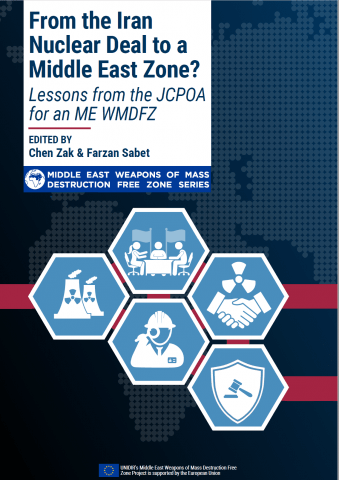

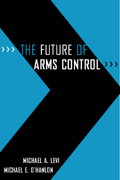
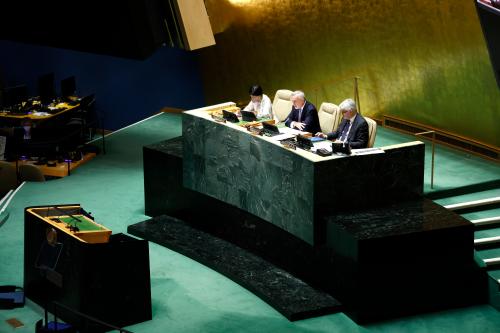
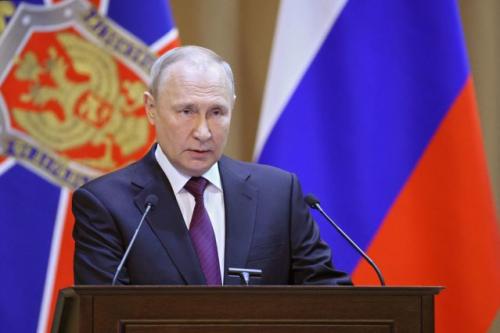
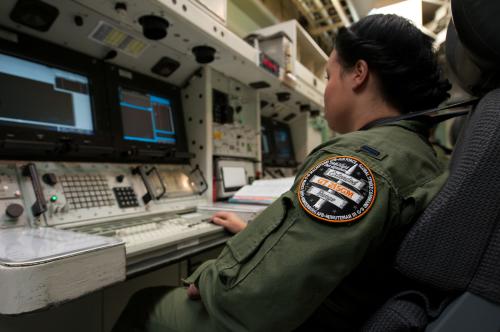



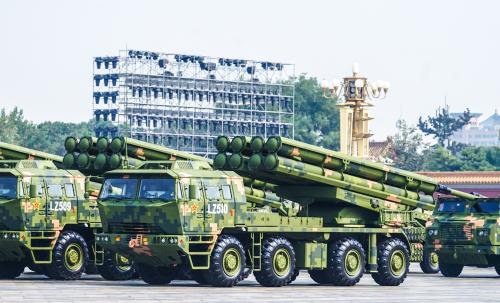
Commentary
Will Putin’s invasion spur nuclear proliferation?
May 24, 2023